|
Part 2 of 4
4. Carving the statues
In Easter Island ... the shadows of the departed builders still possess the land ... [T]he whole
air vibrates with a vast purpose and energy which has been and is no more. What was it? Why was
it?
– Katherine Routledge1
Fig. 4.1 Unfinished statue at Rano Raraku.
A total of 887
moai have so far been catalogued on Easter Island, including 397 at the quarry
– the volcanic crater of Rano Raraku. Rano Raraku is one of the world’s most
extraordinary and evocative archaeological sites. A great many statues were being sculpted there
when activity apparently came to an abrupt halt.
Francis Mazière writes:
Here in this lunar landscape they carved giants that belong to another world; the impression is
shattering. Everything here is on the most tremendous scale, and it all gives rise to a strong feeling
of distress, for everything seems to have stopped suddenly, in a single day, as though it had been hit
by the blast of some enormous disaster. ... It is this which gives the sanctuary its unearthly
feeling.2
Fig. 4.2 Statues still in their extraction cavities.
Most of the island’s statues are 5.5 to 7 m tall, and very few are shorter than 3 m. The vast majority are made of Rano Raraku tuff, including all those erected on platforms. About 55 statues are made
of other stone – red scoria, basalt, or trachyte – and are smaller than the average size
of 5 m. The largest statue ever made, El Gigante, still lies unfinished at Rano Raraku. It was a
monstrous 21.6 m (71.9 ft) long, and weighed up to 270 tons.
Carvers completed the front and sides,
but never liberated it from the rock below.
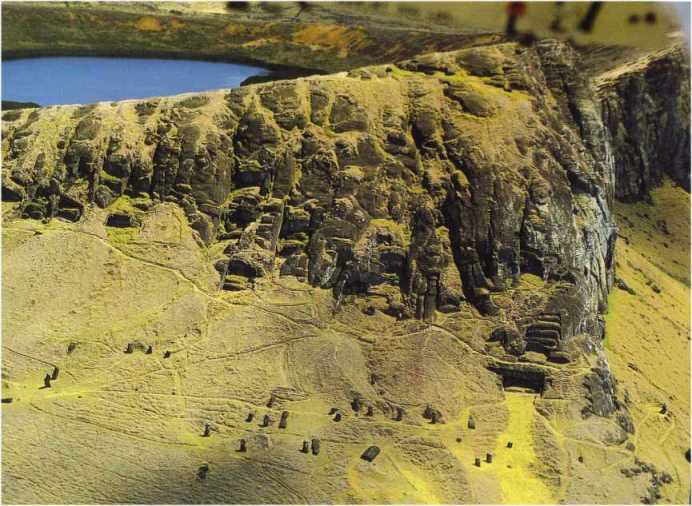
Fig. 4.3 Exterior quarry and slope of Rano Raraku. El Gigante can be seen
towards the right, just above the path.3
(courtesy of Carlos Huber)
More than
230 finished statues were erected on the ahu platforms. A single platform might have
up to 15 moai in a row, with some rows of statues being built up over time. The platform figures tend
to be stockier and less angular than those at the quarry, with less accentuated features and less
concave or prominent noses and chins. The biggest, at Ahu Hanga te Tenga, is 9.9 m (32.5 ft) long.
The statue known as
Paro, which once stood on Ahu te Pito Kura, is 9.8 m long and
weighs 82 tons.
Fig. 4.4 Paro.
Appearance
Although all the giant
moai are similar, no two are exactly alike.
Their base is about where the
statue’s hips would be, the arms hang stiffly, and the hands, with long slender fingers, extend
across a protruding abdomen. The heads are elongated and rectangular, with heavy brows and
prominent noses, small mouths with thin, pouting lips, prominent chins, and elongated earlobes,
some of which are carved to represent inserted ear ornaments.
The statues’ physical features
do not look at all Polynesian.
John Macmillan Brown writes:
Taken as a whole they express haughty scorn and imperious will; it is the expression of
victorious warriors and empire-makers ... Though the arrogant and resolute look is given to the faces
of all the statues, it is never the same on two faces; every one looks as if it had been intended to be
an individual portrait ...1
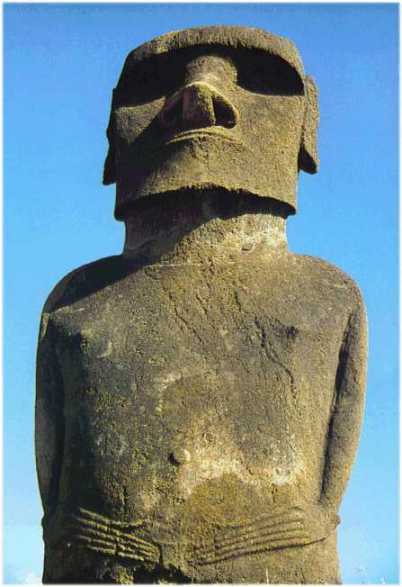
Fig. 4.5 A platform statue.
Early European explorers received the impression that the Easter Island statues were idols, but
no moai is known to have borne the name of a divine personality, such as the creator god
Makemake. All were known by the general name of aringa ora, the ‘living
faces’ of the past. Captain Cook’s party heard the term ariki (chief)
applied to some, while others had nicknames such as ‘Twisted Neck’, ‘Tattooed
One’, and even ‘Bad Smell’ (due to the upturned nostrils).
They are generally
regarded as stylized representations of deified, high-ranking ancestors, serving to keep their memory
alive, and as intermediaries between the world of the living and the world of the gods. It is thought
that the coastal statues faced inland towards the villages to provide protection, by projecting the
mana (occult power) of the akuaku (ancestral spirits) they represented.
Their location close to the shore may also have been designed to prevent encroachment by the sea,
in view of native legends that the original settlers had fled a partly submerged island.
Figures with hands resting on their stomach are common in the Marquesas and elsewhere in
Polynesia, and also in South America. In the traditional Maori carving of New Zealand, the hands
were placed there to protect ritual knowledge and oral traditions, which were believed to be carried in
the belly.
Jean-Michel Schwartz says that the position of hands indicates the point on the abdomen
– the she men or ‘stone door’ – where Chinese medicine
situates the ancestral centre of procreational energy and vitality, and the seat of immortality.2
It is believed that the statues may have been commissioned during the lifetime of elders, but
that they did not have their eyes carved until they had been moved to the platforms – after the
person had died. Only the platform statues were given eye-sockets, and in 1978 it was discovered
that the sockets were once fitted with beautiful inlaid eyes of white coral and red scoria. Some
platform statues were also given a red ‘hat’ (pukao), and there are signs that some
may have been painted red and/or white.
The straightness or concave curve of the statues’ noses contrasts markedly with the
frequently arched noses on the island’s wooden figures, and art historian
Max Raphael
argued that the nose was shaped as a symbolic phallus, while the pouting or protruding thin lips with
a groove between them suggest the form of a vagina. The islanders held that the entire
moai was a
phallic symbol.
As regards the reason for the statues’ elongated ears,
H.P. Blavatsky made the following comments on long-eared statues of the Buddha:
‘The unnaturally large ears symbolize the
omniscience of wisdom, and were meant as a reminder of the power of Him who
knows and
hears all, and whose benevolent love and attention for all creatures nothing can
escape.’3
The actual physical elongation of the ears as a mark of
social rank and power in many different cultures may have arisen after the original purely symbolic
meaning had faded.
The squared shape between the fingers of the statutes is thought to represent the
hami, or sacred loincloth worn by chiefs and priests, or a kind of penis cover or shield.
Many statues have detailed carvings on their backs, which are often interpreted as tattooed signs of
rank. Some statues also bear carvings of birdmen, double-bladed paddles, and vulva signs, but
these seem to be later additions. The lines that curve across the small of the back are often said to
represent a ‘belt’ associated with the loincloth.
However, this is unlikely since it
consists of an arched rainbow motif that does not continue round to the sides and front.
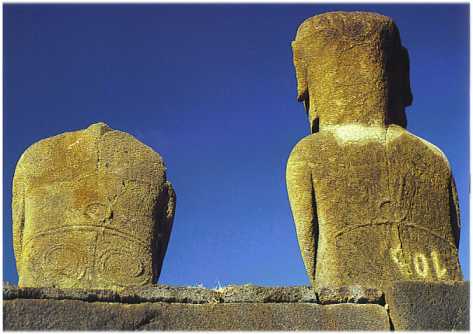
Fig. 4.6
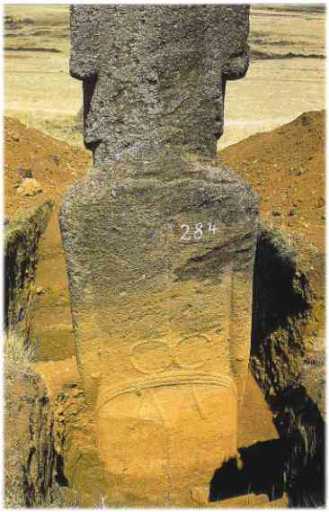
Fig 4.7
Some islanders interpreted the triple bow with a circle (or sometimes two) above it and an M-shaped design below
it as representing a rainbow with the sun above and rain beneath.4
Francis Mazière was told by a native that they represent the elements of life: sun, moon, and
thunder, with thunder signifying electricity.5
Schwartz argues that they
represent the three elements of the universe: sunlight, water or sea, and mountain or earth. He says
that the circle at the level of the sacrum indicates that mana entered there; ancient Chinese medicine
calls that part of the body ming men or ‘door of life’.6
Some writers, including
H.P. Blavatsky, have drawn attention to the overall
resemblance of these three symbols to the Egyptian ankh, also known as the
ansated cross or tau, which signifies life, regeneration, and the descent of spirit into matter.7
Fig. 4.8 This basalt statue, 8.2 ft tall and weighing 4 tons, is now in the British Museum.
Carving
Rano Raraku contains numerous now empty niches where statues have been hacked out, as
well as 397 figures visible on the outer and inner slopes illustrating every phase of the carving
process. As a result of rubble and silt being washed down the slope, the statues set up at the foot of
the quarry now stand so deep in the earth that no one has succeeded in pulling them
down.
Large areas of the quarry are in fact hidden under slope deposits, and many more
moai
undoubtedly remain to be discovered.
Fig. 4.9 A statue excavated by Heyerdahl’s team.
The yellow-brown tuff of Rano Raraku is compacted volcanic ash. The hardness of the rock
should not be judged by the crumbly outer surface of the statues. The figures are as hard as bone
below the outer surface, and so is the exterior surface where it has not been subjected to the rain.
The Spanish visitors of 1770 struck a statue with a hoe, and sparks flew. At some time, an attempt
was made to decapitate a statue, but it ended in failure and the damage extends no further than a
hand’s breadth into the giant neck. Using a hammer and chisel, a member of
Heyerdahl’s team took half an hour to chip off a bit of rock the size of a fist in the quarry.1
Other writers seem to contradict this, saying that underneath the outer layer,
the rock is not much harder than chalk, and can be cut and shaped quite easily even with stone
tools.2
But it should be noted that
the quality of the rock varies widely.
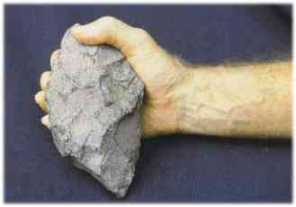
Fig. 4.10 A toki.
The quarry was once littered with thousands of crude pickaxes (toki) made of
dense basalt. During the Norwegian expedition, Heyerdahl hired six men who used these tools to
outline a 5 m (16 ft) statue. The rock was frequently splashed with water to soften it, but the picks
quickly became blunted and had to be repeatedly sharpened or replaced.
It took three days to
produce a statue outline, after which they gave up.3
On the basis of this
very scanty evidence it was somehow calculated that six men, working every day, could have
completed a medium-sized moai in 12 to 15 months.
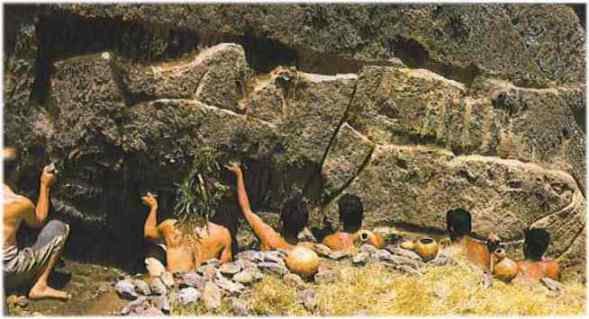
Fig. 4.11 Moai outlined by Heyerdahl’s team.
Most
moai were carved face up, in a horizontal or slightly reclining position, usually with their
base pointing down-slope, though some point the other way, others lie parallel to the mountain, and
some are almost vertical – apparently to avoid wasting any space.
First the sculptors opened
up channels about 60 cm wide and 1.5 m deep around a volume of rock, and then proceeded to
carve the head, body and sides, leaving a keel along the back, to keep it attached to the bedrock.
With the statue held firm by a packing of stones and fill, the keel was finally hacked away.
The
quarry displays plenty of evidence of breakage or of figures having been abandoned due to defects
in the stone.
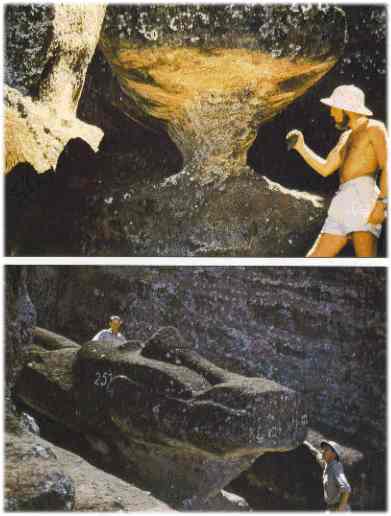
Fig. 4.12
The statue then had to be moved down the slope (of about 55°), without damaging it or
any other statues on the way down. Depressed runways or channels of earth seem to have been
used for this purpose. It is thought that ropes may have been attached to horizontal wooden beams set
transversely in the channels leading down the slopes.
Some
moai had to be lowered down the vertical cliff face, and then
maneuvered over statues on which work was still proceeding on the ledge below.
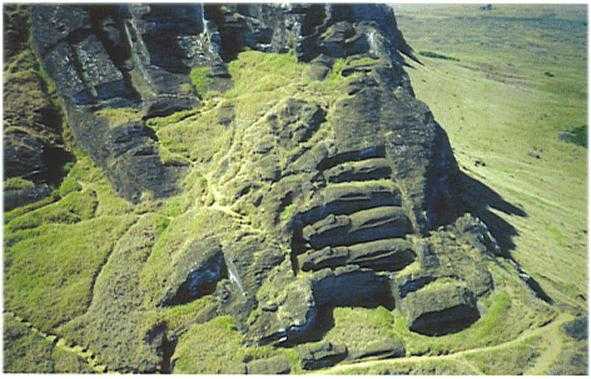
Fig. 4.13 Statues still lying at the top of Rano Raraku, where they were
carved.4
(courtesy of John Flenley)
At the highest point on the inner face of the crater, there are a series of cylindrical holes over
one meter in depth and width, with horizontal channels connecting them at the bottom.
One view is
that large tree trunks were stood in them with ropes around them, though some of the holes are
puzzling, and it is thought they may have been used for coiling and storing the rope. But even if such
a hoisting system once existed, it would only have been of use to operations at one part of the inner
slope.
Archaeologist
José Miguel Ramírez argues that, given their location above a marginal area of
the main quarries, the holes ‘do not seem to be related to the sliding of the moai,
but to an ancient game called ma’ari, which consisted of going up and down the
volcanic cliff with the use of ropes, as in a cableway’.5
Fig 4.14 Holes at the summit of Rano Raraku.
Near the foot of both the inner and outer quarry slopes, workers raised the statues into a
standing position in holes or on terraces, and sculptors finished carving their backs. One of the
island’s mysteries is why most of the carving was done before moving the statues to the
platforms and even before bringing them down the quarry slope, instead of simply cutting out rough
blocks, and then hauling them to a more convenient working place.
About 200 statues are still standing on either side of the crater’s lip, all with their
backs to the hill. Although only the heads usually project above the surface, they are full statues like
those on the platforms, the tallest being over 11 m (36 ft) in height. On the plain adjacent to the outer
slope about 30 more statues lie on the surface, mostly on their fronts. Others are scattered along
prehistoric ‘roads’ or tracks heading out of the quarry. It is commonly believed that the
statues on the crater slopes were awaiting transportation to the platforms, but had not yet been
moved because the people they represented were not yet dead, or because there was no room on
the platforms or no resources for transportation.
If the intention was to move all the statues to the platforms, it is not clear why some were
quarried inside the crater given the additional effort required to get them out of there. Many
researchers think that the statues inside the crater were not intended to be removed, but were set up
there permanently, facing the lake. This would explain why far more statues were left finished or
unfinished at the quarry than could ever have been erected on existing platforms.
The statues at the foot of the outer slope of the crater appear to be set up in the ground in a
disorderly fashion, some alone, some in clusters, sometimes blocking one another’s view.
The arrangement of the standing statues inside the crater is more regular, but there still appears to
be no order.
Researchers such as
Katherine Routledge, who headed the first archaeological
expedition to Easter Island in 1914/15, and Francis Mazière, thought that some, if not all, of
the statues standing on the outer slope may also have been intended to remain there, guarding the
volcano. Some of the upright statues are in fact standing on stone pavements. Most standing
statues, on both slopes, were raised roughly along an axis running from NW to SE, and every statue
had a slightly different orientation.
Mazière was told by a native that all the
Rano-Raraku
moai are sacred, and ‘each looks at a part of the world over which he has power and for
which he is answerable’.6
|
|
Fig. 4.15 Two giants’ heads, their bodies buried by erosion. Regarded as some of the oldest and purest statues, they are just under 40 ft high. |
References
-
Katherine Routledge, The Mystery of Easter Island, Kempton, IL: Adventures
Unlimited Press, 1998 (1919), p. 165.
-
Francis Mazière, Mysteries of Easter Island, London: Collins, 1969, p.
128.
-
José Miguel Ramírez and Carlos Huber, Easter Island: Rapa Nui, a land
of rocky dreams, Alvimpress Impresores, 2000, p. 71.
Appearance
-
John Macmillan Brown, The Riddle of the Pacific, Kempton, IL: Adventures
Unlimited, 1996 (1924), p. 17.
-
Jean-Michel Schwartz, The Mysteries of Easter Island, New York: Avon, 1975, p.
193.
-
H.P. Blavatsky, The Secret Doctrine, Pasadena, CA: Theosophical University
Press, 1977 (1888), 2:339.
-
Thor Heyerdahl, Easter Island: The mystery solved, New York: Random House,
1989, p. 191.
-
Mazière, Mysteries of Easter Island, pp.
130-1.
-
Schwartz, The Mysteries of Easter Island, pp. 119, 183, 193.
-
The Secret Doctrine, 1:322; H.P. Blavatsky Collected Writings (vols.
1-14), Wheaton, IL: Theosophical Publishing House, 1950-85, 7:297-8.
Carving
-
Thor Heyerdahl, Aku-Aku: The secret of Easter Island, London: George Allen
& Unwin, 1958, pp. 130-1, 137-8.
-
John Flenley and Paul Bahn, The Enigmas of Easter Island, New York: Oxford
University Press, 2002, pp. 114-5.
-
Heyerdahl, Easter Island: The mystery solved, p. 203.
-
The Enigmas of Easter Island, plate ix.
-
Ramírez and Huber, Easter Island, pp. 66, 79.
-
Mazière, Mysteries of Easter Island, p. 124.
Back to Contents
The islanders have a legend that the statues were moved to the platforms and raised upright by
the use of mana, or mind power. Either the god Makemake, or priests or chiefs commanded
them to walk or to float through the air, and according to one legend, use was made of a finely crafted
stone sphere, 75 cm (2.5 ft) in diameter, called te pito kura (‘the golden
navel’ or ‘the navel of light’), to focus the mana.
Legends about the use of
levitation in the construction of megalithic monuments are found all over the world.1
Fig. 5.1 Te pito kura.
Some writers have said that high up on the rim inside the Rano Raraku crater is an open
rock-hewn cave with a series of rock benches or seats lining its walls, oriented towards the crater
lake. According to one tradition, seven masters, or magicians, sat together on the benches and
combined their mana to make the statues walk out of the crater and around the island in a clockwise
spiral.2
However, the ‘open cave’ could also be seen as
nothing but an ordinary extraction cavity from which the statue has been removed, and irregular
‘seat-like’ depressions can be found elsewhere in the quarry.
Fig. 5.2
Above: ‘Seats’ in an ‘open cave’, or an
empty extraction cavity?
Below: A sketch showing how the ‘seats’ may have arisen.
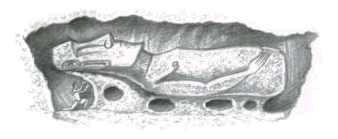
Francis Mazière was one of the few scholars to take the legends about
mana seriously:
What if certain men at a certain period were able to make use of electro-magnetic or
anti-gravitational forces? ... [O]n the sheer side of the volcano there is something wonderfully
strange. Here statues were brought down over the top of dozens of others, without leaving any
marks. Yet the movement of ten or twenty tons is by no means child’s play. ...
The natives say that everything died on Easter Island when
mana left it, while at the same time
I see the amazing evidence of a quite extraordinary past. It may be that para-psychology will find a
sympathetic vibration in this island with its perturbed, confusing magnetism.3
All modern mainstream researchers believe that muscle-power alone is sufficient to move the
statues to the ahu, sometimes more than 20 km away, and to erect them. During Heyerdahl’s
Norwegian expedition, about 180 men, women, and children pulled a 4 m (13 ft) statue weighing
around 10 tons for a short distance on a sledge using two ropes.
It would therefore have taken 1500
people to have moved Paro’s 82 tons, and the ropes would need to be several
centimeters in
diameter and 80 m long. The required manpower can be reduced significantly by pulling the sledge over log rollers. In a 1998 experiment organized by
Jo Anne Van Tilburg, 40 men were able to move a 9-ton replica statue using this method.
The main problem in transportation is thought to be not so much the statues’ weight (the
average being no more than 18 tons) but their fragility, since it was important not to damage the
elaborate detail already carved on the figures. If transported on their fronts or backs, the statues
would have required considerable wrapping and padding with vegetation to protect them, since none
show any signs of rope marks or other damage.
A major problem would arise as the columns of
people pulling the sledge neared the coastal platform, as there would be nowhere for them to go
– except into the sea. It is thought that this problem could have been solved by using levers.
In one experiment, 12 men levered a 6-ton rock 15 ft in 1.5 hours. However, it has not yet been
demonstrated that these methods could be used on a statue of average height and weight without
damaging it.
Geologist
William Mulloy suggested using a curved Y-shaped sledge made from the fork of a
big tree, on which the statue rests face-downwards. Two gigantic wooden legs in the shape of a ‘V’ are attached to the statue’s
neck by a loop, and when the legs are tilted forward, the rope partially lifts the statue and takes some
weight off the sledge. The statue could therefore be rocked forward using the bulging abdomen as a fulcrum or pivot point.
However, this technique – which has never been tried out in practice – puts
particular stress on the statues’ fragile necks and not all the statues have the protruding
stomachs ideal for this method.
Fig. 5.3 Mulloy’s method.
Czech engineer
Pavel Pavel discovered that statues can be moved upright; they
can in fact be made to ‘walk’. Two ropes are attached to the top of the statue and used
to pull it to each side alternately, while another two are fastened down at the base and alternately
pulled forward. As one team pulls on the top rope to make the statue tilt to the right, the other team
pulls the left-hand side of the base forward before the giant tips back again.
The teams then change
sides, causing the statue to walk by wriggling forward from side to side. Mazière was told by
a native that ‘the statues moved standing upright, making half turns on their round
bases’, and many researchers believe that this is the method being referred to.
In one experiment on the island, a 2.8 m (9 ft) statue of 4 or 5 tons was moved using this
method; only 3 men were needed to tilt it, and 5 to pull it forward. A 4 m (13 ft) statue of 9 tons was
also moved in this way.
Only 16 people were required to move it a distance of 6 m: 7 tilting and 9
pulling forward. It could therefore have been moved 200 m per day. It was so stable that it could tilt
70° without falling. This is because of the statues’ ingenious design: the thickness from
front to back of the upper part is so insignificant compared to the bulky lower body that the centre of
gravity is almost at the navel.
Upright transportation avoids the need to take a standing statue at the
quarry, tip it over onto a sledge, then raise it again at the platform.
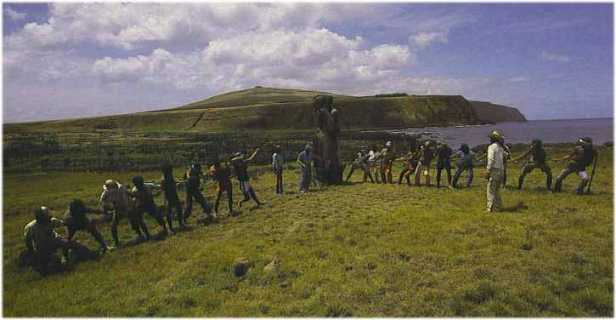
Fig. 5.4 Tilt-and-swivel technique.4
During experiments conducted by geologist
Charles Love in Wyoming, a 10-ton, 4-m replica
statue, equivalent to the smallest 20% of the moai, was moved by crews of 14 to 21 men, but chips
came off the front of its base, and the figure toppled over twice. Some researchers think that the
tilt-and-swivel technique was probably used only for moving very short distances or for final
positioning. Many researchers say that the bases of the statues do not show the amount of wear
expected from this technique.
Heyerdahl disagreed: he argued that statues that have not travelled far
from the quarry have perfectly flat bases, but the farther away from the quarry they are, the more
convex their bases become, until many of those erected on platforms have the edges of their bases
completed rounded off from wear.
If the statues were moved upright, they would not have toppled over on a gentle slope of 10 or 12
degrees as they have a slightly forward-slanting base – stones had to be placed under some
of those on reconstructed platforms to prevent them leaning forward. On the descending side of the
slope, the statue could simply be turned round and moved backwards.
Love’s team found that if they placed a statue upright on two logs carved into
sledge runners, and then raised it onto a track of small wooden rollers, it could be moved 45 m in 2
minutes using 25 men and 2 ropes. Some see this as the most efficient method for long-distance
transportation: it causes no damage, and requires little wood, not much rope, and few people.
Van Tilburg, on the other hand, says that both this method and the tilt-and-swivel method are incredibly dangerous:
‘The logistics of any upright method suggested to date are daunting-to-impossible on the rolling Rapa Nui terrain.’5
These two methods have yet to be tried out with taller statues on steep slopes. The results might be entertaining.
Fig. 5.5 Sledge-and-roller method.
(courtesy of Charlie Love)
The general view is that different transportation techniques were used according to the size and
style of figure, the distance to be travelled, and the manpower, timber, and ropes available. It has
been suggested that some figures might even have been transported 500 m to the shore and then
floated on timbers or rafts around the coast to the platforms. At several points around the coast there
are lava-flow causeways and paved ramps.
There are unconfirmed reports from fishermen that submerged
moai have been seen on the seabed.
Roads
Katherine Routledge discovered three main roads, each about 3 m wide, branching out from
Rano Raraku. They were revealed when the level rays of the sinking sun showed up inequalities in
the ground. Fallen statues lie along certain parts of the roads, but at very irregular intervals. The
southern road can be traced from Rano Raraku, with one or two gaps, nearly to the foot of Rano
Kao. 29 fallen statues lie scattered along it, most over 20 ft tall and some over 30 ft.
Another road
ran through a gap in the crater wall toward the western part of the island. It is not as regular as the
south road, and has 14 statues, which grow further apart as the distance from the mountain
increases. The third road runs in a northerly direction and is much shorter than the other two. It has
only 4 statues covering a distance of about a mile, but the furthest image is the largest to have been
moved (36 ft 4 in).
Routledge wrote:
‘Rano Raraku was therefore approached by at least three magnificent
avenues, on each of which the pilgrim was greeted at intervals by a stone giant guarding the way to
the sacred mountain.’1
In addition, there are signs that some of
the statues on the southeastern side of Rano Raraku may have been on a fourth road along that side
beneath the cliff, and a platform on the south coast was approached by an avenue with 5 or 6
statues.
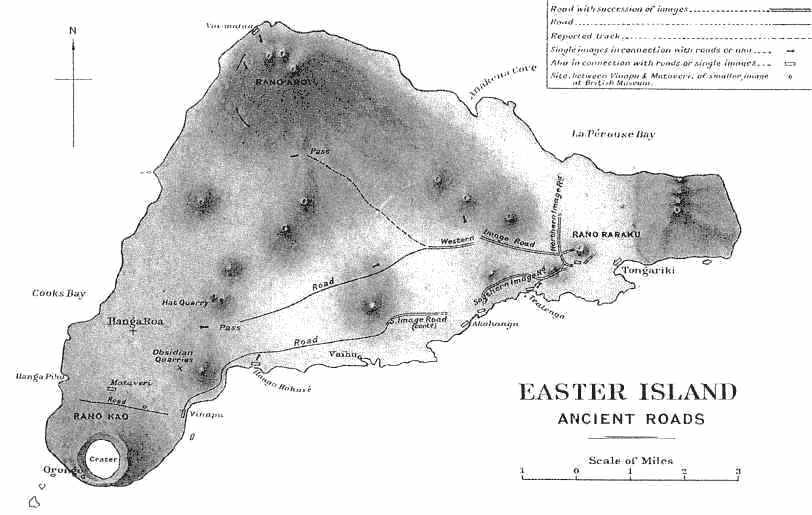
Fig. 5.6
Many researchers disagree with Routledge and believe that all the statues found between the
quarry and platforms were in the process of being moved. Geologist Christian O’Brien,
however, felt that at least 56 of the 61 statues now found scattered on and off old roads in the
island’s interior are in the place intended for their erection.2 Some
of them stood on stone pavements, as did some of the upright statues at the foot of Rano Raraku.
Charles Love has examined about 20 km of the 40 km of roads built from
Rano Raraku,
focusing on the three main roadways plus several branch roads.
Flenley and Bahn describe his
preliminary findings as ‘startling’:
[The roads] traverse old basalt flows and the shallow valleys between them, and have a basic
cut-and-fill construction; excavation of 10 m and 20 m stretches has revealed how they were cleared,
cut, graded and, in many places, filled with soil. Various grades up and down slopes were cut and
filled to help the statue movers, and it is clear that a great deal of cooperative
labor was required for
these roads – in the valleys, the fill construction can be built up to a
meter or more with layers
of clayey soil to make a flat surface about 5 m wide.
In at least one area, a pavement was made,
apparently to facilitate the movement of Paro through a section of rough bedrock. Some stretches of
road were carved into the surface of the higher basalt flows, apparently to avoid a flat surface, with
paths cut into a shallow V or a broad U shape, about 5.5 m wide and 30 cm deep (though in other
places the roads seem half-worn in the ground surface, rather than cut into bedrock).
Some
segments of road have long rock alignments along the shoulders, which seem to be kerb-stones set
into the backfill, while others have numerous post holes dug into bedrock outside the kerb-stones
– presumably to accommodate some kind of contraption for pulling and
pricing the statue and
its framework forward in places ... Such features seem most common where the roadway slopes
upwards.
Regarding the methods used to transport the statues, they add:
[W]e need to go back to the drawing board, because researchers have always assumed that
the island’s roadbed surface was flat and the road horizontal; but ... none of the
moai-moving theories or experimental methods presented so far can cope with the
structure of the roads he [Love] has excavated! The cut parts of the road are not conducive to rollers
or tilting a statue along, and any contraption used would have to accommodate both the flat fill
surfaces and the V-shaped surfaces. So the mystery of statue transportation remains
intact ...3
Furthermore, the fragile statues were transported to many distant
ahu, up and down steep hills
and over rough and stony ground, where there is no trace of any road at all.
Katherine Routledge
relates the following anecdote:
We were once inspecting an ahu built on a natural eminence, one side was sheer cliff, the other
was a slope of 29 ft, as steep as a house roof, near the top a statue was lying. The most intelligent of
our guides turned to me significantly. ‘Do you mean to tell me,’ he said, ‘that
that was not done by mana?’4
Routledge points out that besides the ceremonial roads and their continuations, there are traces
of a different track which is said to run round the whole seaboard of the island. It is known as
Ara
Mahiva, ara meaning ‘road’ and Mahiva being the name of the spirit or
deity believed to have made it. The road showed up as a continuous furrow: on the northern and
western coasts it runs for much of the way along cliff tops, and it runs up both the eastern
and western edges of Rano Kao.
Routledge comments:
‘This silent witness to a forgotten past
is one of the most mysterious and impressive things on the island.’5
This road is referred to in a
rongorongo tablet known as Apai, which was recited
independently by two islanders.
It contains the following:
When the island was first created and became known to our forefathers, the land was crossed
with roads beautifully paved with flat stones. ... Heke was the builder of these roads, and it was he
who sat in the place of honor in the middle where the roads branched in every direction. The roads
were cunningly contrived to represent the plan of the web of the grey and black-pointed spider, and
no man could discover the beginning or end thereof.
At this point the recitation was interrupted because of unintelligible text in another language, but
then comes a reference to a different ‘spider’, this one living in the aboriginal
homeland (Hiva),
‘where the black and white-pointed spider would have mounted to heaven,
but was prevented by the bitterness of the cold’.6
According to this legend, the island once had a network of roads resembling a spider’s
web, radiating out from a central point, perhaps Rano Raraku. No network of this kind is visible
today, though the existing roads could have formed part of it. We do, however, find an intriguing
correspondence in Peru.
The Nazca Plain is covered with numerous straight lines, zigzags, spirals,
and geometrical figures, drawn on the surface of the desert by removing the mass of volcanic
pebbles and boulders, and scraping off the surface layer of the earth. There are also outline
drawings of faunal species – some of them hundreds of feet in extent – including a
spider monkey, a gigantic lizard, a condor, an unidentified beaked creature, and a
Ricinulei spider.
To draw the giant spider, the artist used a single line which turns and weaves but never
crosses itself; in other words, it was drawn so that no one could discover where the line began or
ended – just like the web of roads referred to in the rongorongo text.

Fig. 5.7 The Nazca spider, said by some researchers to represent Orion.
Raising the statues and headdresses
All the statues standing on platforms today have been re-erected during restoration work over
the past 50 years. The first to be re-erected was a medium-sized (20 ton) statue at Ahu Ature Huki,
Anakena, during Heyerdahl’s expedition in 1956. Twelve islanders used two wooden poles to
raise it 3 m onto its platform by gradually slipping rocks underneath, and they had it standing in only
18 days.1
Since the levers were used against the statue itself, large
scars were caused. All experiments to date have involved horizontal statues, but it is thought that if
the figures arrived upright at their platforms, they could have been raised in the same gradual way,
by being titled first one way and then the other, as stones or logs were inserted beneath them.
Massive ramps do not seem to have been used to raise the statues onto
platforms; this would have involved colossal amounts of extra labor.
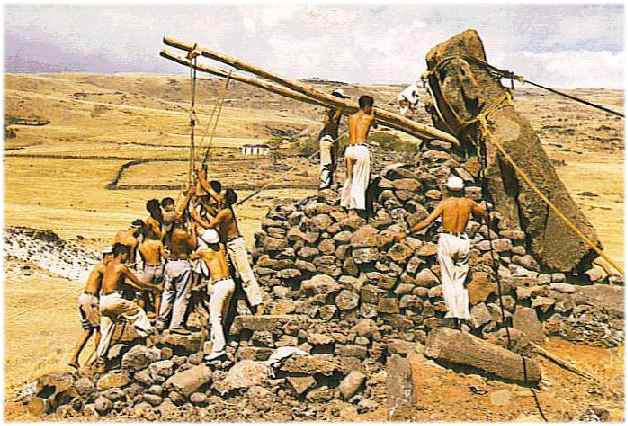
Fig. 5.8 Re-erecting the statue at Ahu Ature Huki.
The
pukao – the headdress or ‘topknot’ – is a soft red-scoria
cylinder quarried from the small crater at Puna Pau. Some take the form of a truncated cone, while
others have a narrower knob at the top. Since only about 60 statues have them, they are believed to
be a late addition, associated only with statues on the largest and most important platforms.
Some
researchers see them as a sign of continuing rivalry between villagers or kin-groups.
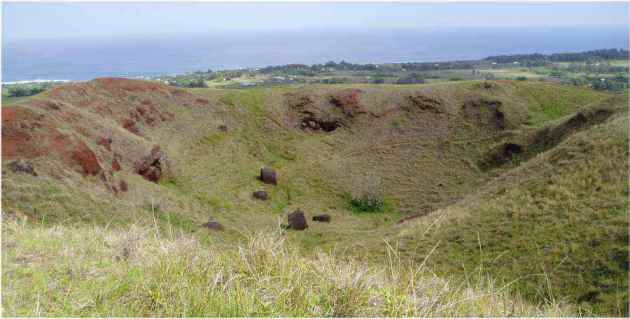
Fig. 5.9 Interior of Puna Pau.
As at Rano Raraku, work at Puna Pau seems to have ceased unexpectedly, as about 30
cylinders lie inside or just outside the quarry. They range from 6 to 9 ft in diameter, are
4 to 8 ft high, and weigh up to 20 tons; nearly all of them are now carved with
petroglyphs. According to legend, they were moved by mana, but the conventional view is that they
were rolled out of the quarry and over the hilly terrain to their destinations using levers.
No one has
yet given a practical demonstration of this, and no traces of tracks leading out of the crater and
across the rugged volcanic terrain have been found. The headdresses seem to have been reworked
on reaching the platforms.
Some were carved to a more elliptical cross-section, and a shallow
mortise was made in the base; some of the Anakena statues have tenons on their heads to fit these
mortises.
Fig. 5.10 Pukao outside the crater.
Placing the headdresses on top of the statues’ heads was a tremendous feat of
engineering. Those to be seen today on restored statues were all put there by cranes (fig. 5.11), and not
without difficulty. Captain Cook suggested that ramps and scaffolding were used. Some scholars
have proposed that the cylinders were lashed to the statues and both were raised together, but this
is generally considered to be far too risky.
Experiments by
Pavel Pavel show that some pukao may
have been put in position by gradually pulling them up sloping beams of wood. A concrete
pukao, 1
m in diameter and weighing 900 kg, was raised onto the top of a 3 m concrete moai by only 4 men in
6 hours (fig. 5.12).2
It should be borne in mind, however, that
Paro’s monstrous pukao, which was by no means the biggest, measures almost 2 m across,
1.7 m high, weighs about 11.5 tons, and had to be raised 10 meters into the air.
Fig. 5.11
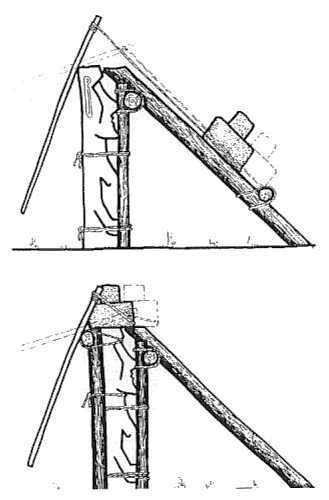
Fig. 5.12
In the past, the reddish cylindrical headdresses have been regarded as hats, baskets, or
crowns. Ancient-astronaut enthusiast Erik Von Däniken saw them as space helmets! The
islanders call them pukao, which means ‘topknot’, a male hairstyle common on Rapa
Nui when Europeans first visited the island, and the present consensus is that this is what they
represent (fig. 5.13).
However, in the Marquesas, a great stone was placed on the image of a dead
man as a sign of death and mourning, and some believe the pukao may have had a similar meaning.
Flenley and Bahn believe that they are a stylized version of the hau kurakura, a red
feather headdress worn by warriors. Throughout Polynesia, red was associated with ritual and chiefly
power, and red feathers were identified with the spiritual power of the gods.
Jean-Michel Schwartz held that the pukao were a sign of knowledge, and the seat of the mystical force known as
mana; all island traditions agree that it was the head that bore
mana.3
Fig. 5.13 An islander with a topknot.
In conclusion, despite the numerous theories that have been put forward regarding the carving,
transportation, and erection of the statues and their headdresses, and despite the numerous
experiments that have been carried out, we are still very far indeed from having solved all the mysteries.
References
-
See ‘Gravity and antigravity’,
section 5
-
David Hatcher Childress, Lost Cities of Ancient Lemuria & the Pacific,
Stelle, IL: Adventures Unlimited Press, 1988, pp. 319-20.
-
Francis Mazière, Mysteries of Easter Island, London: Collins, 1969, pp.
134-5.
-
Thor Heyerdahl, Easter Island: The mystery solved, New York: Random House,
1989, p. 240.
-
www.pbs.org/wgbh/nova/easter/move/past.html.
Roads
-
Katherine Routledge, The Mystery of Easter Island, Kempton, IL: Adventures
Unlimited Press, 1998 (1919), pp. 197-8.
-
Christian and Barbara Joy O’Brien, The Shining Ones, Kemble,
Cirencester: Dianthus Publishing, 1997, p. 509.
-
John Flenley and Paul Bahn, The Enigmas of Easter Island, New York: Oxford University Press, 2002, pp. 131-3.
-
The Mystery of Easter Island, p. 198.
-
Ibid., p. 199.
-
Heyerdahl, Easter Island: The mystery solved, p. 111; The Shining
Ones, p. 510.
Raising the statues and headdresses
-
Heyerdahl, Easter Island: The mystery solved, pp. 204-6.
-
Flenley and Bahn, The Enigmas of Easter Island, p. 144.
-
Jean-Michel Schwartz, The Mysteries of Easter Island, New York: Avon, 1975, pp.
16, 107, 113.
Back to Contents
|